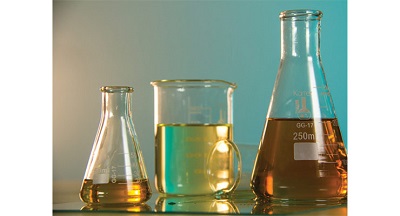Problems that crop up in hydraulic systems are often caused by contaminants like dirt and water in the oil that lead to corrosion, wear and premature failure. But many performance problems are due to another contaminant: varnish that coats control valves, restricts filters, and fouls reservoirs and other internal parts.
 Most hydraulics users are aware of hard, insoluble contaminants like dirt, debris and wear particles. Varnish, in contrast, is considered a soft, insoluble contaminant. Varnish primarily results from excessive heat and oxidation of the oil as well as degradation of additives. The degradation process accelerates as the fluid undergoes continued exposure to air, water, and high temperature.
Most hydraulics users are aware of hard, insoluble contaminants like dirt, debris and wear particles. Varnish, in contrast, is considered a soft, insoluble contaminant. Varnish primarily results from excessive heat and oxidation of the oil as well as degradation of additives. The degradation process accelerates as the fluid undergoes continued exposure to air, water, and high temperature.
Varnish particles are less than 1 micron in size and are not measured by traditional particle-count testing methods or removed by conventional filtration. Varnish forms a thin-orange, brown or black film deposit — a tough, hard contaminant that coats internal machine surfaces. The reaction products tend to precipitate onto cooler surfaces, like reservoir walls, and onto valves and other working parts, especially when equipment shuts down overnight or on weekends.
Varnish deposits on hydraulic system components leads to trouble such as:
• Sluggish operation, as increased friction and stiction in mechanical parts such as spools and sleeves cause valves to stick or seize.
• Restricted oil flow and clogging of small orifices, valves, strainers, and filters.
• Reduced bearing clearances that limit lubrication.
• The ability to capture hard, abrasive contaminants that accelerate wear.
• Acting as an insulator, restricting heat transfer from reservoirs and heat exchangers and raising operating temperatures.
• Serving as a catalyst, speeding fluid deterioration and forming more varnish.
All of these issues can affect performance and efficiency. It can increase wear in pumps, valves, gears and bearings. Increased friction and restricted flow raises energy consumption. Accelerated corrosion hastens component failure.
In the end, the cycle time to manufacture a part or move an implement increases, lowering productivity. Valves and filters must be replaced more often. Maintenance costs rise and equipment life suffers. In extreme cases, sensitive hydraulic valves can abruptly seize and fail if varnish goes undetected, costing thousands of dollars in downtime, damaged components and ruined products.
Historically, visual inspections were performed to identify varnish buildup. But traditional oil analysis testing, which is important for maintaining oil and machine health, has not been a reliable, cost-effective procedure to identify the presence of varnishing conditions.
Fortunately, several methods have been developed to test for varnish in a fluid and system. Membrane patch colorimetry (MPC) varnish potential testing (ASTM D7843) is an analytical test to determine the propensity for a lubricant to form varnish deposits. MPC involves filtering a defined fluid sample through a membrane, and color of the contaminants are measured against a control membrane patch.
The ultra-centrifuge method spins an oil sample to separate out varnish precursors. The sediment is checked against a visual rating scale. Remaining useful life tests measure active antioxidants in the lubricant. And Acid Number (ASTM D974) measures the total acid number in the fluid. Acid depletes antioxidants, leading to varnish formation.
Bureau Veritas, with U.S. headquarters in New York City, has developed an innovative program called Quantitative Spectrophotometric Analysis (QSA) that can accurately determine the likelihood of a used lubricant producing harmful sludge and varnish.
The QSA program is based on a series of new procedures that determine a specific rating for the used fluid. Based on the lubricant type and the application, this rating lets a trained diagnostician determine the presence or likelihood of internal sludge and varnish build-up.
QSA is fundamentally based on spectrophotometry. This test method measures how a chemical substance absorbs light by detecting the intensity of a light beam that passes through a solution. Specific compounds absorb or transmit light over a certain range of wavelengths. This measurement can also determine the amount of a known chemical substance. Spectrophotometry is widely used for quantitative analysis in chemistry, physics, material and chemical engineering and medical applications.
Quantitative Spectrophotometric Analysis is a technique for purposely isolating and measuring the specific lubrication degradation by-products responsible for varnish formations. It is not a measure of varnish already formed; it is a determination of the lubricants propensity to form varnish and can be applied to preventing varnish formations and build-up within the system. Results are represented as the Varnish Potential Rating (VPR) with a scale of 1 (no varnish) to 100 (severe fouling).
QSA is an integral part of a comprehensive test and analysis procedure Bureau Veritas calls QSA Complete. It includes spectrochemical testing (ASTM D6595), viscosity D445, acid number D974, water content D1744 , ISO particle count ISO 11171, in addition to Quantitative Spectrophotometric Analysis.
Samples that show a high VPR may indicate the need to change out the oil. Some fluid-additive manufacturers have developed system cleaners that remove varnish, without manual scrubbing or hazardous solvents; and hydraulic-fluid additive packages that prevent new varnish from depositing on valves and reservoir walls.

Leave a Reply